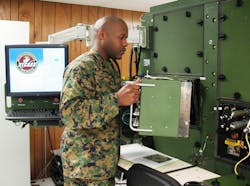Navy continues to upgrade obsolescent avionics test and measurement systems until replacements come online
LAKEHURST, N.J. – Test and measurement experts at Lockheed Martin Corp. will continue to upgrade, maintain, and support obsolescent U.S. Navy combat avionics test equipment under terms of a $34.5 million order announced last week.
Officials of the Naval Air Warfare Center Aircraft Division in Lakehurst, N.J., are asking the Lockheed Martin Rotary and Mission Systems segment in Orlando, Fla., to provide performance-based logistics maintenance and support for as many as 400 Consolidated Automated Support System (CASS) avionics test stations and 150 Reconfigurable Transportable CASS (RTCASS) stations.
CASS has been a Navy standard automatic test equipment family supporting electronics on naval aircraft. Originally fielded in the 1990s, CASS includes mainframe CASS stations installed in aviation intermediate maintenance departments (AIMDs) ashore and afloat worldwide. RTCASS support forward-deployed Marine Corps aviation logistics squadrons.
All mainframe CASS systems are being replaced by electronic CASS (eCASS) due to approaching obsolescence. The eCASS is a technologically-advanced system to replace mainframe CASS in support of the Fleet for the next 20 years.
Related: Wanted: upgrades to avionics EW test and measurement gear
Until eCASS replaces all necessary CASS avionics test equipment, Navy leaders must ensure that the older CASS equipment remains working reliably.
CASS is designed to help warfighters troubleshoot and repair aircraft assemblies at sea or ashore and return the avionics to service quickly. At its peak usage around 2000, CASS was the world's largest automated test support program, and was the Navy's standard test equipment for avionics on aircraft carriers and in depots throughout the U.S.
CASS production started in 1990 to replace specialized avionics testers at sea. When they were procured originally the CASS mainframes cost about $1 million each.
The test and measurement systems were designed with open-systems architectures to detect and isolate faults in avionics equipment on such carrier-based aircraft as the E-2C radar surveillance turboprop, EA-6B electronic warfare jet, F-14 jet fighter, F/A-18 fighter-bomber, AV-8B jump jet, S-3 surveillance jet, and SH-60 helicopter.
Related: SWaP-optimized instruments for flight line test and measurement
Prior to CASS this function required 25 separate old testers. CASS systems at sea are installed on all the Navy's aircraft carriers and most amphibious assault ships.
Lockheed Martin delivered the first modernized eCASS station to replace older CASS equipment in late 2014 to support all the aircraft in the Navy’s fleet, including the F-35 Lightning II joint strike fighter.
On this order Lockheed Martin will do the work in Orlando, Fla., and should be finished by April 2023. For more information contact Lockheed Martin Rotary and Mission Systems online at www.lockheedmartin.com, or the Naval Air Warfare Center Aircraft Division-Lakehurst at www.navair.navy.mil/lakehurst.

